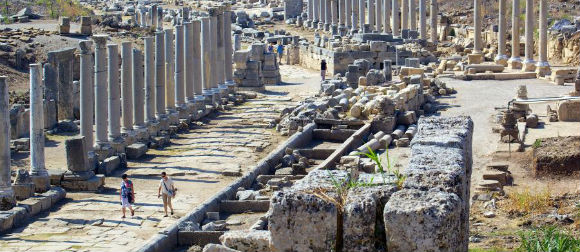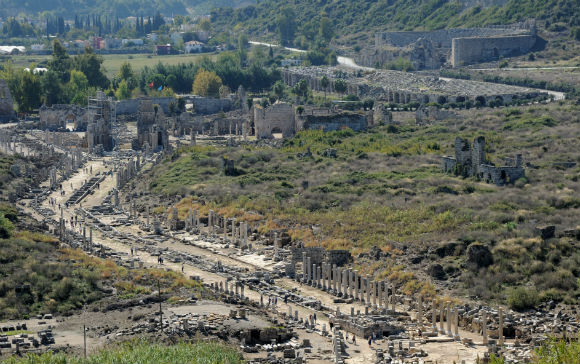The most impressive ruins of the Pamphylian coast are at Perge, at about 15 km east of Antalya. Perge was originally founded by the Hittites around 1500 BC. and was known as Parha. It was a successful trading centre near the Aksu (ancient Kestros or Cestrus) river when Alexander the Great arrived in 333 BC. He was welcomed in by the inhabitants and used Perge as base for his Anatolian campaigns. Alexander was followed by the Seleucids under whom the city prospered and Perge’s most celebrated inhabitant, the mathematician Apollonius from Perge lived and worked. Apollonius was a pupil of Archimedes and wrote a series of eight books on geometry. In 188 BC Perge became part of the Roman Empire during which the city flourished. Most of the surviving buildings date from this period.In 46 AD St. Paul started his journey in Perge (biblical Perga) and preached his first sermon here. Perge gradually declined during the Byzantine period, as the Aksu river silted, but remained inhabited until Selçuk times after which it became abandoned.
A visit to Perge starts by entering the archeological site through the Roman Gate, built during the reign of Septimius Severus (193-211 AD). Proceeding through the gate, to the right is the Agora or market place. This structure of 75 x 75 m dates back from the 2nd century AD. The center courtyard and shops were surrounded by a wide stoa, a covered walkway. The floor of the stoa and shops was made of colored mosaics. The agora was not only the centre of Perge’s trade, but was also a place for meetings as well as a forum for political, social, and philosophical discussions. The next building is the Hellenistic city gate that dates back to the 3rd century BC. This is certainly the most imposing building of the city and was cleverly designed to protect the city with its twin towers and its horseshoe-shaped courtyard at the back. It is thought that the towers had three floors and were crowned by a conical roof. In the year 121 AD, the horseshoe-shaped courtyard was rededesigned as a courtyard of honor. Behind the courtyard stood a triple arch. Around the arch there are about dozen inscriptions connected with Plancia Magna who lived in the 2nd century AD. She was the daughter of the governor, a priestess of Artemis Pergaia (Diana) and a benefactress to the city. Plancia Magna had the arch decorated with the statues of the emperors and their relatives.
After passing through the Hellenistic Gate and courtyard, one enters a broad, marble-paved double-colonnaded street measuring 300 meters in length that extends from the main gate to the acropolis. The street is 20 m wide and is divided in two by a 2 meter wide water channel running down the middle. At the end of the colonnaded street is the Nymphaeum, a triumphal fountain from where a stream flowed down into the water channel. The nymphaeum or nymphaion is an ornamental semicircular structure and dates from the reign of Emperor Hadrian (130-150 AD). A statue of a river god Kestros was located in the center of this huge fountain. Behind the nymphaeum is the acropolis with some remains of the Byzantine period. To the west of the nymphaeum are the remains of a palaestra dating from 50 AD and dedicated to the Emperor Cladius (41-54 AD).
Returning back to the entrance, there are the excavated Roman baths located southwest to the agora. Out of the site proper, is the horsehsoe-shaped stadium, the largest in Asia Minor, measuring 234 m by 34 m. The stadium had a seating capacity of 12,000 people supported by massive barrel-vaulted constructions. Just beyond the site entrance is also the theatre, which is of the Greco-Roman type and could seat 15,000 people. Unfortunately, it is for some time under reconstruction and unfortunately closed to visitors.
Perge,



We took a trip to Perge to see the ruins of an ancient city. It was well worth the trip. Smaller than Ephesus it was still remarkable to stand in a place so old.,
Not crowded with tourists. Site of the recent finds in the region and it's easy to arrange a toure of Perge and other nearby attractions.
On a business trip to the area I took a day to check out the ruins. Hard to fathom the architectural genius that created the amphitheatre. While standing at the top one of our group standing at the base broke out singing a cappella. Each word and tone were crystal clear, never mind that the singer had a good voice….
For Roman civilisation-phobes a must see place. Lots to view, in fact allow a morning or afternoon to wander around the theatre, stadium etc.
If you are interested in archaeology this is one place that will interest you. It is one of the better ruin sites I have seen.Not to be missed. Mainly level ground.
Fascinating trip, although it was baking hot the day we went. It's an on-going archeological dig that was really well explained by our guide who gave a insight into B.C.civilisations.
Incredibly well-preserved ruins with a magnificent example of the Roman heating system of their baths. You can walk down the main street like the Romans would have done and observe the commercial agora in all its glory. I recommend going at any period other than summer because it gets VERY hot and there is not much shade!
Beautiful site, goes on and on, mixing so many traditions it is a little overwhelming. See it early before it gets too hot
Amidst the large hubbub of Antalya and all its other attractions is one that eluded me during my trip planning. The only reason I found it, was seeing a brown tourist attraction road sign called “Perge”, and looking up the name back at my hotel. I am happy to have seen it and glad to rate Perge as a must…
Well preserved baths were great! Columns impressive. It is very hot, bring water and sunscreen. Bargain with vendors…be careful they give you change. Well worth a visit.